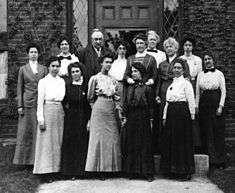Margaret Harwood
| Margaret Harwood | |
|---|---|
 | |
| Born |
March 19, 1885 Littleton, Massachusetts |
| Died |
February 6, 1979 (aged 93) Boston, Massachusetts |
| Nationality | American |
| Fields | astronomy |
Margaret Harwood (March 19, 1885 – February 6, 1979[1]) was an American astronomer and the first Director of the Maria Mitchell Observatory in Nantucket, Massachusetts who specialized in photometry.
Early Life and Education
Margaret Harwood was born in 1885 in Littleton, Massachusetts. She was one of nine children of Herbert Joseph Harwood and Emelie Augusta Green. She attended Radcliffe College and graduated in 1907 with an AB where she was a member of Phi Beta Kappa. In 1916 she received her AM from the University of California.
Career
After graduating college she worked at the Harvard Observatory. She also taught in private schools in Boston, Cambridge and Dedham. In 1912, she was awarded the astronomical fellowship of the Nantucket Maria Mitchell Observatory, a small observatory built as a memorial to the first woman astronomer in America. In 1916, she was appointed Director of the Observatory, eventually retiring in 1957. Her particular field was photometry, measuring variation in the light of stars and asteroids, especially that of the small planet Eros. A member of the American Astronomical Society and Fellow of the Royal Astronomical Society, Miss Harwood corresponded with fellow astronomers and traveled widely in Europe and the United States. Margaret Harwood was a devoted Unitarian and worked in a voluntary capacity for the Nantucket Cottage Hospital, the Nantucket School Committee and the Red Cross of Nantucket. Some other notable things she has done include teaching at MIT during World War II, mentoring students, and serving as a trustee of Nantucket College Hospital.

Achievements
Her discovery of the asteroid 886 Washingtonia was quashed four days before its formal recognition. At the time, Harvard mentors found it inappropriate for women to receive public recognition for these discoveries.[2]
She was also the first woman to gain access into the Mount Wilson Observatory, which was the world's largest observatory at the time.[3]
In September 1960, the scientific trio of Cornelis Johannes van Houten, Ingrid van Houten-Groeneveld and Tom Gehrels discovered an asteroid and promptly named it in Harwood’s honor. 7040 Harwood (2642 P-L) sits in the main asteroid belt between Mars and Jupiter.[2]
Death
She is buried at the Westlawn Cemetery in Littleton.[2]
Honors
Harwood was the first woman to receive an Honorary Ph.D from Oxford University. In 1960, 2542 P-L was discovered by Cornelis Johannes van Houten and Ingrid van Houten-Groeneveld and named Harwood in honor of Margaret Harwood.[4] In 1962, she received the Annie J. Cannon Award in Astronomy.[5] Won the Woman's Astronomical fellowship of the Nantucket Maria Mitchell Association - See more at: http://www.wickedlocal.com/article/20120410/News/304109549#sthash.qmlxqiDy.dpuf
References
- ↑ https://familysearch.org/ark:/61903/1:1:VZ5J-N6Y
- 1 2 3 Clark, Thomas (April 10, 2012). "Littleton astronomer Margaret Harwood remembered for achievements". Wicked Local. GateHouse Media. Retrieved March 25, 2014.
- ↑ Leonardo, Jascin (December 16, 2013). "Nantucket's Daring Daughters: A Brief Look At Margaret Harwood". Nantucket Chronicle. Retrieved March 25, 2014.
- ↑ Schmadel, Lutz (August 5, 2003). Dictionary of Minor Planet Names, Volume 1. Springer Publishing. p. 572. ISBN 9783540002383. Retrieved March 25, 2014.
- ↑ "Annie J. Cannon Award in Astronomy". American Astronomical Society. Retrieved September 10, 2012.
Further reading
- Jane Lancaster. Making Time: Lillian Moller Gilbreth, A Life Beyond "Cheaper by the Dozen". Retrieved September 10, 2012.
- Sweeper in the Sky: The Life of Maria Mitchell, First Woman Astronomer in America. Nantucket Maria Mitchell Association. 1959.
- A Scientific utpost: The First Half Century of the Nantucket Maria Mitchell Association. Nantucket Maria Mitchell Association. 1968.
- Shearer, Benjamin F.; Shearer, Barbara S. (1997). Notable Women in the Physical Sciences: A Biographical Dictionary. Westport, CT: Greenwood Press. pp. 176–178. ISBN 0-313-29303-1.
External links
- Littleton astronomer Margaret Harwood remembered for achievements
- Papers of Margaret Harwood, 1891-1971. Schlesinger Library, Radcliffe Institute, Harvard University.